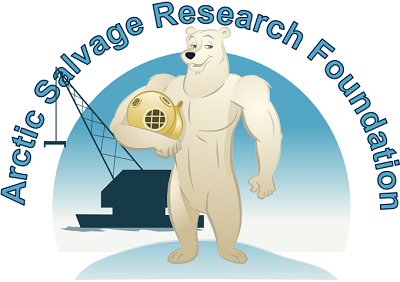Action Needed on Arctic Saturation Diving
Captain Scott Powell, president of the Arctic Salvage Research Foundation, is developing the program for evaluating the equipment and procedures needed for salvage operations in the Arctic including the potential for saturation diving.
 Captain Powell managed the response programs involving saturation divers when hurricanes Ivan, Rita and Katrina downed oil platforms in the Gulf of Mexico. “We set up five vessels for salvage operations with saturation diving systems that allowed us to keep dive teams at working at depth pressures while they remove debris and gained access to the downed wells to kill them. Saturation diving enabled the work to continue around the clock, and it is safer than having divers continually returning to the surface when long durations at depth are required. As the divers only decompress every month or so, you are reducing the risk of them getting decompression sickness.”
Captain Powell managed the response programs involving saturation divers when hurricanes Ivan, Rita and Katrina downed oil platforms in the Gulf of Mexico. “We set up five vessels for salvage operations with saturation diving systems that allowed us to keep dive teams at working at depth pressures while they remove debris and gained access to the downed wells to kill them. Saturation diving enabled the work to continue around the clock, and it is safer than having divers continually returning to the surface when long durations at depth are required. As the divers only decompress every month or so, you are reducing the risk of them getting decompression sickness.”
In saturation diving, the divers live in a pressurized environment that matches the pressures they experience working in deep water. Decompression sickness can occur when they are decompressed if the gas they breathe during diving forms bubbles that damage tissue or block blood vessels.
What was achieved in the Gulf of Mexico case was one of the most remarkable safety records for heavy salvage operations, says Captain Powell. The job ran for seven years without any diver fatalities or injuries, conducting some of the most hazardous and intricate debris removal jobs in history and involving over 500 men and women offshore daily.
Could something similar be done in the Arctic if there was a need for technical salvage operations? “Yes. Saturation diving is viable in the Arctic for a technical response, but the systems and environmental controls need to have a thorough engineering and technical review.
“The diving component of salvage is an extremely technical operation. Then add extreme temperatures and you have a need for new procedures. Currently Arctic or cold climate dive operations are based on surface dive operations which are good for short term shallow to mid water operations requiring minimal bottom time. Yet with the planned oil and gas activities and increased vessel operations in the Arctic, the potential need for sustained diver operations will require new Arctic dive systems engineered specifically for use in Arctic conditions.
“The lessons learned in the Gulf of Mexico cleaning up the downed platforms truly proved the safety and applied knowledge for operational planning and safe execution gained by using saturation diving. It provided new technology for salvage operations and now these types of equipment and lessons learned need to be evaluated for applicability to the Arctic environment.”
 The importance of having the right systems and procedures is what sparked Captain Powell’s participation in establishing the Arctic Salvage Research Foundation in Anchorage, Alaska, in January this year.
The importance of having the right systems and procedures is what sparked Captain Powell’s participation in establishing the Arctic Salvage Research Foundation in Anchorage, Alaska, in January this year.
The foundation will help salvage companies put the correct equipment, technology and training in place either in house or externally. This in turn will provide assurance to the underwriting community that correct and effective salvage resources are being used. The foundation will therefore act as a platform with international recognition to improve salvage response and safety in the Arctic, says Captain Powell.
The foundation is set up to be self-funding through project research and development and equipment reviews. Projects will be identified, costs estimated and then reviewed and funded by the foundation participants or a specific requester. The foundation will then assemble the best resources to properly execute the project.
“One of the key goals of the foundation is to work with salvage companies and dive companies who are interested in being prepared for work in the Arctic, by reviewing their existing equipment from the engineering and operating procedures side to determine if the equipment is fit for deployment in Arctic conditions.
“From a technology perspective, the Arctic is an area that holds the opportunity to help refine and define new and advanced equipment, challenging the engineer and inventor in all of us that accept the challenge of helping to safely open new frontiers. There have been very few Arctic salvage and fire-fighting operations carried out, so we must apply what we have learned in Arctic operations and engineering, and apply it to salvage execution preparedness,” says Captain Powell.
The foundation is currently preparing a training course specifically designed to assist senior managers of companies with Arctic operations to better understand how salvage operations are conducted including types of contracting, equipment, levels of response for Arctic operations and navigation.
.jpg) “Companies that intend to either transit the Arctic or have a presence there already have to meet stakeholders expectations, two of those being the U.S. Coast Guard and the Bureau of Safety and Environmental Enforcement. These regulators have expressed openly that they only want to see equipment and operations that are fit for purpose and Arctic capable being deployed,” says Captain Powell. “The foundation provides the necessary platform for self-regulation through engineering, testing and development of equipment, procedures and training focused specifically on Arctic salvage, diving, and firefighting.”
“Companies that intend to either transit the Arctic or have a presence there already have to meet stakeholders expectations, two of those being the U.S. Coast Guard and the Bureau of Safety and Environmental Enforcement. These regulators have expressed openly that they only want to see equipment and operations that are fit for purpose and Arctic capable being deployed,” says Captain Powell. “The foundation provides the necessary platform for self-regulation through engineering, testing and development of equipment, procedures and training focused specifically on Arctic salvage, diving, and firefighting.”
Captain Powell’s career includes extensive experience developing equipment and vessels for use in the U.S. Arctic and in the Caspian Sea for well control and response operations. He managed the design, construction and approval of the Arctic subsea containment system, managed the worlds large oil field salvage operation in history including the capping of over 700 subsea wells. “I have a lot of knowledge and expertise yet to transfer to the next generation through mentorship of the salvage industry to assure the best equipment and practices are available and applied should a salvage response be required.
“We are looking forward to being an integral part of promoting safe and effective ventures into the Arctic with the reassurance that firefighting, salvage and diving service providers have the right equipment, technology and procedures to carry out a safe and sustainable response operation.”
The opinions expressed herein are the author's and not necessarily those of The Maritime Executive.
